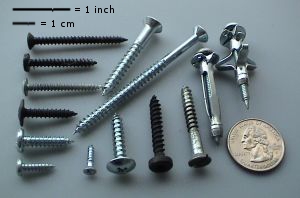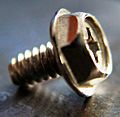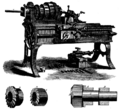Screw facts for kids

A screw is a special type of fastener, a bit like a nail, but with a spiral ridge called a thread around its body. When you turn a screw with a screwdriver, these threads cut into materials like wood or plastic. This action helps the screw hold things together very strongly. Unlike a nail, a screw is much less likely to pull out once it's in place.
Screws can be made from many different materials. Common ones include steel, iron, brass, and bronze. You can even find screws made from plastic for lighter jobs.
There are also special kinds of screws. For example, machine screws are like small bolts. They have threads that fit perfectly into a nut with matching threads. This creates a very secure connection. Self-tapping screws are designed to cut their own threads as they are driven into a material, which can save time.
The size of a screw's thread is measured in different ways. Sometimes it's in millimeters, and other times it's given as a number. Screws are used everywhere around us! You can find them holding together your furniture, keeping doors attached, and even inside many of your home appliances.
Contents
How Screws Work
Using screws is a very neat and strong way to join two materials. One great thing about screws is that if you don't use glue, you can easily take things apart later. This makes repairs or changes much simpler.
Different Types of Screw Heads
Screws come with different types of heads, each designed for a specific purpose. Here are three common ones:
- Countersunk Head: This screw head is flat on top. To use it, you first drill a small hole called a pilot hole. Then, you use a special drill bit called a countersink bit to widen the very top of the hole. This allows the screw head to sit flush, or perfectly flat, with the surface of the material.
- Raised Head: A raised head screw has a slightly rounded, dome-like shape that sticks up a little bit above the surface when fully tightened.
- Round Head: Similar to a raised head, a round head screw also has a domed shape that stays above the surface. It's usually a bit wider and more rounded than a raised head.
Tips for Using Screws Safely
When working with screws, it's important to follow a few simple rules to get the best results and keep things safe:
- Avoid Placing Screws in a Straight Line: Try not to put screws in a perfectly straight line, especially in wood. This can weaken the material and make it more likely to split.
- Use the Right Screwdriver: Always pick a screwdriver that fits the screw head perfectly. If the screwdriver is too small, it can damage the slot on the screw. If it's too big, it might tear the material you're working with.
- Prevent Stripped Threads: Sometimes, if you overtighten a screw or use the wrong size, the threads in the wood or metal can get "stripped." This means the threads are damaged, and the screw won't hold tightly anymore. A stripped screw can also be very hard to remove!
Related Pages
Images for kids
-
A bolt (with a nut) and a screw
See also
 In Spanish: Tornillo para niños
In Spanish: Tornillo para niños








